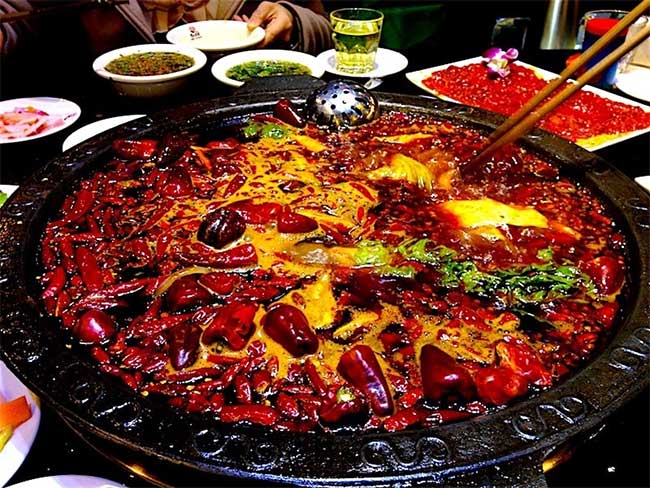Culinary experts in China’s spice capital, Sichuan Province, are developing a scientific index to measure the spiciness of the hot pot of the same name.
This initiative comes after a food enthusiast shared the idea on social media. By May 11, the idea was published by Sichuan Fabu, the official news agency of the Sichuan provincial government, and received widespread support. The news agency added that the Sichuan Hot Pot Association has begun to realize the idea.

Sichuan hot pot is a famous dish in China, often attracting the attention of tourists. (Photo: thefooddictator).
Yan Long, the executive director of the association, stated that this index will explain and convert spiciness into an accurate number, replacing the current vague descriptions of “mild, medium, hot, and super hot”, making it easier for diners to choose according to their taste preferences.
While China boasts many hot pot dishes, the Sichuan variant is the most popular nationwide. According to a report on the hot pot industry published by the China Food and Beverage Research Institute, the number of Sichuan hot pot restaurants topped across China, accounting for 12.4% of the total, equivalent to 395,000 restaurants, by the end of 2021. Not only in China, this dish has also garnered attention worldwide.
Sichuan cuisine is also served in about one-third of the approximately 600,000 Chinese restaurants, generating a total value of $36 billion, according to the World Sichuan Cuisine Conference held in Chengdu in 2018.
James McDougall, director of the Social Sciences and Humanities program at Sichuan University – Pittsburgh Institute, believes that the globalization of Sichuan cuisine restaurants since the 2000s is a result of China’s efforts to enhance its soft power abroad. Sichuan dishes are known for their diverse spicy flavors, ranging from numbing to sour spice, created from various types of peppers and unique ingredients.

The spiciness of Sichuan dishes is created from various types of peppers and unique spices. (Photo: Shutterstock).
Many believe that the people of Sichuan developed a habit of eating spicy food during the Qing Dynasty (1636-1912) to cope with the region’s characteristic humid weather. The Sichuan hot pot originally emerged as a “poor man’s dish,” created by dock workers along the Yangtze River for a quicker and cheaper meal.
Some industry insiders explain that this spicy flavor became popular nationwide because Sichuan cuisine is less expensive and takes less time to prepare and serve compared to other famous Chinese dishes.
Additionally, because the sensation of spiciness from peppers is actually a pain sensation rather than a taste sensation, consuming spicy food releases endorphins and dopamine, chemicals that make people feel more comfortable.
However, not all domestic and international tourists enjoy the spiciness. Upon hearing that the Sichuan Hot Pot Association is about to establish a spiciness index, one user commented online: “Thank you. I only like very, very, very mild spice.” Currently, the “mild” descriptor often found in Sichuan is spicier than in other regions of China.
Other opinions suggest that it is impossible to establish a universal standard. “Different people have different perceptions of spiciness. It is very difficult to cater to all preferences,” commented a social media user.


















































